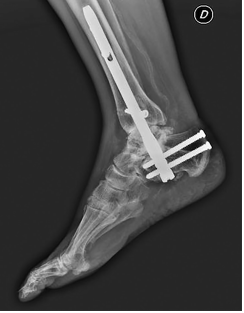Objective: The aim of this study was to evaluate clinical and functional outcomes in diabetic patients undergoing tibiocalcaneal arthrodesis using a retrograde nail.
Methods: A total of 12 diabetic patients [8 men and 4 women; mean age at intervention: 56.8 years (range: 27-76 years)] who underwent tibiocalcaneal arthrodesis by a retrograde nail were enrolled in this study. The indication for surgery was massive talar osteonecrosis in four patients, Charcot arthropathy in another four patients, and various severe ankle/hindfoot derangements in four patients. All surgeries were performed by the same surgeon. All patients were evaluated by their American Orthopedic Foot and Ankle Score (AOFAS) score, and radiographic follow-up was performed.
Results: The mean follow-up time was 59.5 months (range: 27-121 months). Ten patients (83.3%) healed and were able to walk with full weight bearing without crutches. Among them, nine patients (75%) achieved union with solid bone healing. The mean overall improvement in the AOFAS score was 72.5% (preoperatively: 40 points vs postoperatively: 69 points; p<0.001). We observe a complication in 50% of our patients. Minor complications included two cases of dehiscence of the surgical wound, one case of soft tissue irritation owing to hardware protrusion, and one cause of lymphedema. Two patients had deep infection and underwent surgical removal of hardware, debridement, and antibiotic treatment: one healed after the treatment but never recovered full weight bearing and the other one died from other complications. These two deep infections occurred after 23 months of follow-up.
Conclusion: Tibiocalcaneal arthrodesis using retrograde nails is a salvage technique extremely effective in ankle and hindfoot disorders in a diabetic patient. This procedure allows good functional outcomes and pain relief. When correctly indicated, it is a safe procedure with good clinical outcomes and low risk of below-knee amputation.
Level of Evidence: Level IV, Therapeutic study
Cite this article as: Vitiello R, Perna A, Peruzzi M, Pitocco D, Marco G. Clinical evaluation of tibiocalcaneal arthrodesis with retrograde intramedullary nail fixation in diabetic patients. Acta Orthop Traumatol Turc 2020; 54(3): 255-61. DOI: 10.5152/j.aott.2020.03.334.



.png)
.png)

